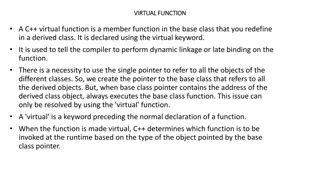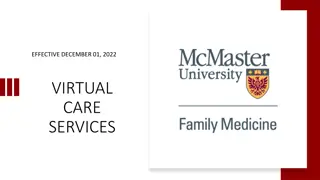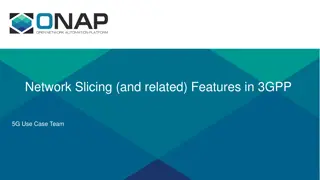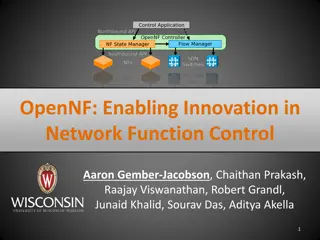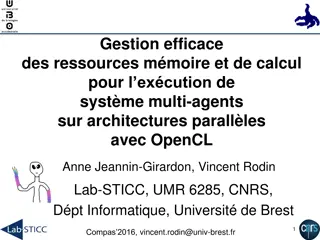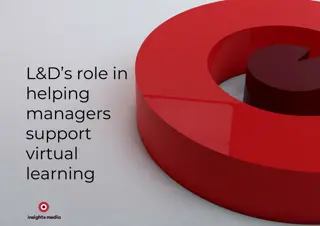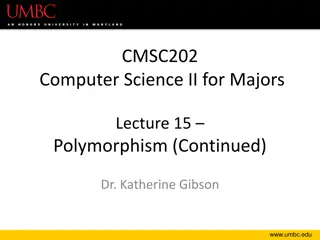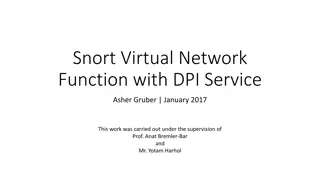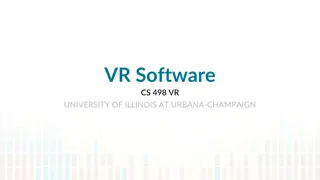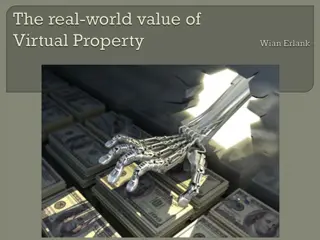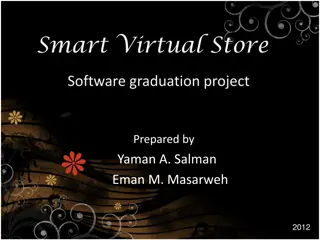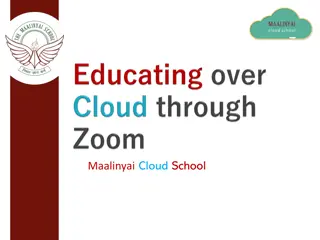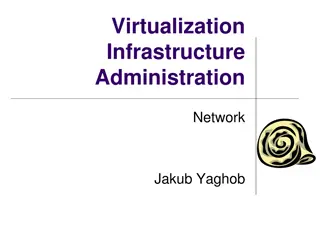Virtual Labs and Cybersecurity Overview at 2021 Winter ICT Educators Conference
Welcome to the 2021 Winter ICT Educators Conference featuring sessions on virtual labs on SDN, Open Virtual Switches (OVS), cybersecurity, and more by Jorge Crichigno from the University of South Carolina. The agenda includes discussions on motivation, NETLAB environment, software-defined networking
7 views • 36 slides
Modeling and Generation of Realistic Network Activity Using Non-Negative Matrix Factorization
The GHOST project focuses on the challenges of modeling, analyzing, and generating patterns of network activity. By utilizing Non-Negative Matrix Factorization (NMF), realistic network activity patterns can be created and injected into live wireless networks. Understanding and predicting user behavi
4 views • 28 slides
Network Function Abstraction A delicate question of (CPU) affinity?
Exploring the delicate balance of CPU affinity in network function abstraction, including challenges, benefits, and solutions like CPU pinning for network workloads. Learn about the impact on performance and scalability, as well as the importance of proper configuration in virtual and physical envir
3 views • 40 slides
Understanding Renal Function Tests and Kidney Health
Renal function tests are essential for diagnosing and monitoring kidney health. These tests assess functions like glomerular filtration, tubular reabsorption, and endocrine functions of the kidneys. Common indicators include serum urea, creatinine levels, and more. It's crucial to evaluate renal fun
0 views • 34 slides
Understanding Virtual Functions in C++
Learn about virtual functions in C++, their importance for achieving dynamic linkage and late binding, rules for defining virtual functions, differences between virtual and non-virtual functions, and examples illustrating their usage. Explore pure virtual functions and their role in creating abstrac
0 views • 7 slides
Important Guidelines for Virtual Care Services in Ontario
Virtual care services in Ontario effective December 01, 2022, require both patient and physician to be located in the province for insurance coverage. Specific codes for assessments and consultations have been updated, and services must follow defined criteria for eligibility. Initiating virtual car
0 views • 15 slides
Network Compression Techniques: Overview and Practical Issues
Various network compression techniques such as network pruning, knowledge distillation, and parameter quantization are discussed in this content. The importance of pruning redundant weights and neurons in over-parameterized networks is highlighted. Practical issues like weight pruning and neuron pru
0 views • 37 slides
Network Slicing with OAI 5G CN Workshop Overview
Overview of Network Slicing with OAI 5G CN workshop focusing on the crucial role of network slicing in realizing the service-oriented 5G vision. This workshop covers topics like multiple logical networks creation on shared infrastructure, different types of network slices, preparation and instantiat
1 views • 6 slides
Overview of Network Slicing and Features in 3GPP 5G Use Case Team
Network slicing in 3GPP's 5G architecture allows for the creation of logical networks with specific capabilities. The end-to-end slicing process involves various network functions like Access and Mobility Management Function (AMF), Session Management Function (SMF), and User Plane Function (UPF). S-
0 views • 12 slides
Understanding Snort: An Open-Source Network Intrusion Detection System
Snort is an open-source Network Intrusion Detection System (NIDS) developed by Cisco, capable of analyzing network packets to identify suspicious activities. It can function as a packet sniffer, packet logger, or a full-fledged intrusion prevention system. By monitoring and matching network activity
0 views • 23 slides
Introduction to Gamma Function and Equivalent Integral Forms
The Gamma function is a versatile mathematical function that generalizes the factorial function to non-integer and complex values. It has various integral definitions such as the Euler-integral form. The proof of the factorial property of the Gamma function is demonstrated through analytical continu
1 views • 20 slides
Specialized Virtual Asset Services in Dubai | NH Management
NH Management is a leading virtual asset service provider in Dubai, offering specialized services to facilitate the opening of crypto virtual licenses in the UAE. Whether you\u2019re seeking a virtual license in Dubai or a Dubai virtual business lice
2 views • 8 slides
Requirements for Virtual/Online Teachers in the 2021-22 Academic Year
Legislation in Michigan impacts virtual and online courses, requiring districts to ensure proper teacher placement with valid certifications. Over 75% of sampled school districts had teachers lacking appropriate endorsements for virtual courses. The law mandates direct hire of qualified teachers and
1 views • 26 slides
Transportation Network Modeling and Analysis with C.Coupled SE Platform
This content outlines the features and functionalities of the C.Coupled SE Platform (CSET Platform) developed by the Connetics Transportation Group. It covers aspects such as interface design, inputs merging, purposes, platform development using Cube, TAZs merging, and network attributes. The platfo
0 views • 11 slides
OpenNF: Enabling Network Function Control
OpenNF enables innovation in network function control by supporting various network functions, dynamic allocation of instances, and addressing challenges such as packet loss and SLA fulfillment. The architecture focuses on state export/import, operation guarantees, and efficient handling of NFs with
1 views • 32 slides
Efficient Resource Management for Multi-Agent System Execution on Parallel Architectures with OpenCL
This research focuses on efficiently managing memory and computing resources for executing multi-agent systems on parallel architectures using OpenCL. The study presents a hybrid approach involving population-level molecular virtual chemistry and individual-level virtual cells. The work enhances a p
1 views • 33 slides
Understanding Virtual Reality: Types and Uses
Virtual Reality (VR) is a computer-generated environment that immerses users in realistic scenes and objects. This technology is widely used in entertainment, gaming, cinema, amusement parks, and social virtual worlds. There are three primary categories of VR simulations: non-immersive, semi-immersi
1 views • 10 slides
Understanding the Nervous System: Structure and Function
The nervous system is a complex network divided into the central nervous system (CNS) and peripheral nervous system (PNS). Neuroglia, or supporting cells, play vital roles in maintaining the health and function of neurons. Neurons, the fundamental units of the nervous system, vary in structure and f
1 views • 29 slides
Exploring the Role of Learning and Development in Supporting Managers in Virtual Environments
The role of Learning and Development (L&D) in assisting managers with virtual learning is crucial in today's dynamic work landscape. This article delves into how managers prefer to learn, the impact of virtual working on their learning styles, barriers to optimizing virtual learning, and strategic s
0 views • 27 slides
Meridian: An SDN Platform for Cloud Network Services
Meridian is an SDN platform developed by Mohammad Banikazemi, David Olshefski, Anees Shaikh, John Tracey, and GuohuiWang at IBM T. J. Watson Research Center. The platform focuses on providing cloud network services efficiently. It encompasses an architecture that enables faster and more convenient n
0 views • 21 slides
Overview of Graphing Techniques and Functions
Explore graphing techniques including stretching, shrinking, reflecting, symmetry, translations, and various types of functions such as the identity function, square function, cube function, square root function, cube root function, and absolute value function. Understand vertical and horizontal shi
0 views • 25 slides
Monitoring Thyroid Function After Head and Neck Cancer Treatment
This collection of images and data discusses the importance of monitoring thyroid function after head and neck cancer treatment, specifically focusing on post-treatment thyroid function tests, audits of practices in head and neck units, thyroid function post laryngectomy, and the significance of det
0 views • 11 slides
Understanding Polymorphism in Computer Science II for Majors
Lecture 15 continued with a review of inheritance, overriding, and the concept of polymorphism in computer science. Dr. Katherine Gibson covered the limitations of inheritance, virtual functions, abstract classes, and function types. The class discussed common errors in project 3 and highlighted tod
0 views • 22 slides
Enhancing Network Security Using Snort Virtual Network Function with DPI Service
Deep Packet Inspection (DPI) as a service is explored in this work, aiming to improve performance, innovation, and security in network operations. By extracting DPI from middleboxes and offering it as a shared service, the paper suggests benefits such as optimized packet scanning, enhanced functiona
0 views • 55 slides
Virtual Reality Software System at University of Illinois
The Virtual Reality Software System at University of Illinois leverages a Virtual World Generator to create alternative realities using synthetic models or real-world data. Tasks for the Virtual World Generator involve matched motion and user locomotion, while dealing with challenges like collision
0 views • 33 slides
Understanding Virtual Memory Concepts and Benefits
Virtual Memory, instructed by Shmuel Wimer, separates logical memory from physical memory, enabling efficient utilization of memory resources. By using virtual memory, programs can run partially in memory, reducing constraints imposed by physical memory limitations. This also enhances CPU utilizatio
0 views • 41 slides
Understanding Virtual Worlds and Virtual Property
A virtual world is a computer-moderated environment separate from the physical world, enabling multiple individuals to interact simultaneously. Virtual property refers to objects within these worlds, having economic or sentimental value and deserving legal protection. Virtual crimes like theft occur
0 views • 9 slides
Understanding Network Analysis: Whole Networks vs. Ego Networks
Explore the differences between Whole Networks and Ego Networks in social network analysis. Whole Networks provide comprehensive information about all nodes and links, enabling the computation of network-level statistics. On the other hand, Ego Networks focus on a sample of nodes, limiting the abili
0 views • 31 slides
Smart Virtual Store Software Graduation Project Overview
Smart Virtual Store Software is a project developed in 2012 by Yaman A., Salman E., and Eman M. to simplify shopping through a virtual store concept. The project includes a QR code generator, QR reader, mobile application, server communication, and a website for easy ordering and purchasing of produ
0 views • 33 slides
Virtual Network Mapping: A Graph Pattern Matching Approach
Virtual Network Mapping (VNM) involves deploying virtual network requests in data center networks in response to real-time demands. It facilitates the deployment of virtual networks on physical machines by mapping virtual nodes and links onto substrate nodes and paths, ensuring constraints are met.
0 views • 15 slides
Exploring Virtual Environments in Computing: An Overview
Virtual environments in computing encompass a range of technologies, from virtual memory to virtual machines and virtual execution environments. These environments allow software to run in a different setting than originally designed, minimizing complexities. Key components include virtual memory, m
0 views • 26 slides
Analysis of WLAN Sensing Sequence Design Using Ambiguity Function and Range-Doppler Map
In this document, the authors from Huawei discuss the analysis of employing the ambiguity function for WLAN sensing sequence design. They delve into the ambiguity function's definition, analysis, and its comparison with the range-Doppler map. The document highlights the importance of ambiguity funct
0 views • 15 slides
Maximize Virtual Learning with Maalinyai.Cloud.School
Dive into the world of cloud-based education with Maalinyai.Cloud.School. Explore the concept of learning in the cloud, virtual classrooms, and essential tips for virtual lessons. Discover how to make the most of online learning platforms like Zoom, engage students effectively, and create an interac
0 views • 12 slides
Exploring Network Slicing in Future 5G Networks
The research delves into the design of a 5G-ready architecture known as NFV-based Network Store, aiming to serve as a digital distribution platform for 5G applications. By focusing on network slicing and programmability, the architecture enhances resource efficiency and agility in deploying software
0 views • 17 slides
Understanding vSphere Networking for Virtualized Infrastructure Administration
Explore the intricacies of vSphere networking in virtualized infrastructure administration, including connecting virtual machines to physical networks, configuring port groups for efficient communication, utilizing virtual switches for network traffic management, and more. Learn how to set up and op
0 views • 11 slides
Understanding Linux Virtual Memory Management
The memory management subsystem in Linux ensures fair physical memory allocation for running processes, allowing them to share virtual memory when needed. Processes can have separate virtual address spaces or share memory through mechanisms like Unix System V shared memory IPC. Linux uses an abstrac
0 views • 230 slides
Network Function Virtualization (NFV) Overview
Network Function Virtualization (NFV) focuses on virtualizing network functions to improve efficiency and reduce costs in network infrastructure. The lecture discusses key readings, devices that compose a network, specialization of devices, benefits of one-device-does-anything approach, and the goal
0 views • 21 slides
Enhancing Network Stability with Network Monitoring Systems
Network monitoring is crucial for efficient management and proactive issue detection in a network environment. Factors influencing an effective network system include choosing the best OEM, SLA agreements, and selecting a reliable System Integrator. Reactive monitoring can lead to financial losses a
0 views • 12 slides
Comprehensive Framework for Virtual Memory Research - Virtuoso
Virtuoso is an open-source, modular simulation framework designed for virtual memory research. The framework aims to address performance overheads caused by virtual memory by proposing solutions like improving the TLB subsystem, employing large pages, leveraging contiguity, rethinking page tables, r
0 views • 29 slides
Accelerating Systemic Change Network Inaugural Workshop Summary
The Accelerating Systemic Change Network held its inaugural workshop at Howard Hughes Medical Institute in July 2016 to address the lack of coordination in improving higher education. With a vision to become a professional hub for change researchers in STEM education, the network aims to enhance ind
0 views • 5 slides




